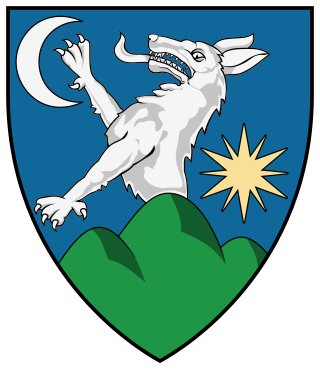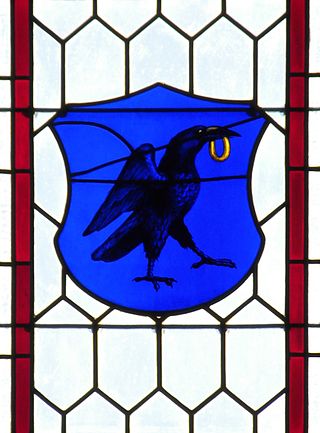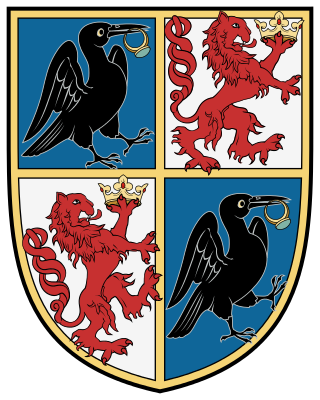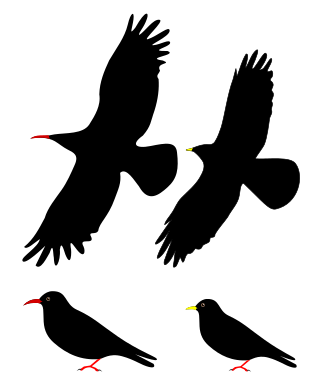
The red-billed chough, Cornish chough or simply chough, is a bird in the crow family, one of only two species in the genus Pyrrhocorax. Its eight subspecies breed on mountains and coastal cliffs from the western coasts of Ireland and Britain east through southern Europe and North Africa to Central Asia, India and China.

There are two species of passerine birds commonly called chough that constitute the genus Pyrrhocorax of the Corvidae (crow) family of birds. These are the red-billed chough, and the Alpine chough. The white-winged chough of Australia, despite its name, is not a true chough but rather a member of the family Corcoracidae and only distantly related.
Marcus Valerius Messalla Corvinus was a Roman general, author, and patron of literature and art.

The coat of arms of England is the coat of arms historically used as arms of dominion by the monarchs of the Kingdom of England, and now used to symbolise England generally, but not officially. The arms were adopted c.1200 by the Plantagenet kings and continued to be used by successive English and British monarchs; they are currently quartered with the arms of Scotland and Ireland in the coat of arms of the United Kingdom. Historically they were also quartered with the arms of France, representing the English claim to the French throne, and Hanover.

Saint Piran's Flag is the flag of Cornwall. The earliest known description of the flag, referred to as the Standard of Cornwall, was written in 1838. It is used by some Cornish people as a symbol of their identity.

Ślepowron is a Polish coat of arms. It was used by several szlachta families in the times of the Polish–Lithuanian Commonwealth. From the fifteenth century, the descendants of the Ślepowron family began to use names taken from their lands. This led to many different surnames being created within one family. The Ślepowron coat of arms is unique in Polish heraldry, in that it is the only coat of arms which is indicative a common origin of individual families, that is, the de Ślepowron, or Korwin, family. Wawrzęta Korwin de Ślepowron is the oldest known ancestor of the family, although the family's oral traditions claim that they descend from Marcus Valerius Corvus, a Roman general.

Korwin is a Polish coat of arms. It was used by several szlachta families in the times of the Polish–Lithuanian Commonwealth and by the Russian Counts Korwin-Litwicki tracing their origin back to Empress Catherine the Great.
The double-headed eagle is an iconographic symbol originating in the Bronze Age. A heraldic charge, it is used with the concept of an empire. Most modern uses of the emblem are directly or indirectly associated with its use by the late Byzantine Empire, originally a dynastic emblem of the Palaiologoi. It was adopted during the Late Medieval to Early Modern period in the Holy Roman Empire, Albania and in Orthodox principalities, representing an augmentation of the (single-headed) eagle or Aquila associated with the Roman Empire. In a few places, among them the Holy Roman Empire and Russia, the motif was further augmented to create the less prominent triple-headed eagle.
In British heraldry, vert is the tincture equivalent to green. It is one of the five dark tinctures called colours.

In heraldry and heraldic vexillology, a blazon is a formal description of a coat of arms, flag or similar emblem, from which the reader can reconstruct the appropriate image. The verb to blazon means to create such a description. The visual depiction of a coat of arms or flag has traditionally had considerable latitude in design, but a verbal blazon specifies the essentially distinctive elements. A coat of arms or flag is therefore primarily defined not by a picture but rather by the wording of its blazon. Blazon is also the specialized language in which a blazon is written, and, as a verb, the act of writing such a description. Blazonry is the art, craft or practice of creating a blazon. The language employed in blazonry has its own vocabulary, grammar and syntax, which becomes essential for comprehension when blazoning a complex coat of arms.

The Szapolyai or Zápolya family was a noble family in the Kingdom of Hungary in the second half of the 15th century and in the early 16th century. A member of the family, John Szapolyai, was King of Hungary between 1526 and 1540, but he only ruled the central and eastern parts of the kingdom, because many Hungarian lords and prelates supported his opponent, Ferdinand of Habsburg.

Hungarian heraldry generally follows German heraldry in its artistic forms, but has its own distinctive character. It is classified to Central and Eastern European heraldry.

Many references to ravens exist in world lore and literature. Most depictions allude to the appearance and behavior of the wide-ranging common raven. Because of its black plumage, croaking call, and diet of carrion, the raven is often associated with loss and ill omen. Yet, its symbolism is complex. As a talking bird, the raven also represents prophecy and insight. Ravens in stories often act as psychopomps, connecting the material world with the world of spirits.

The name Corvin comes from the Latin name Corvinus which derives from the Latin word corvus meaning raven, although the word today refers to the birds' genus including ravens and crows among others.
Árpád stripes is the name of a particular heraldic and vexillologic configuration which has been in constant use since the early 13th century in particular in Hungarian heraldry. It can be seen in the left half of the current coat of arms of Hungary.

The Hunyadi family was one of the most powerful noble families in the Kingdom of Hungary during the 15th century. A member of the family, Matthias Corvinus, was King of Hungary from 1458 until 1490, King of Bohemia from 1469 until 1490, and Duke of Austria from 1487 until 1490. His illegitimate son, John Corvinus, ruled the Duchy of Troppau from 1485 until 1501, and five further Silesian duchies, including Bytom, Głubczyce, Loslau, Racibórz, and Tost, from 1485 until 1490. The Hunyadi coat-of-arms depicted a raven with a golden ring in its beak.
Cornish heraldry is the form of coats of arms and other heraldic bearings and insignia used in Cornwall, United Kingdom. While similar to English, Scottish and Welsh heraldry, Cornish heraldry has its own distinctive features. Cornish heraldry typically makes use of the tinctures sable (black) and or (gold), and also uses certain creatures like Cornish choughs. It also uses the Cornish language extensively for mottoes and canting arms.

The birds of Cornwall are in general a selection of those found in the whole of the British Isles, though Cornwall's position at the extreme south-west of Great Britain results in many occasional migrants. The nightingale is one English bird which is virtually absent from Cornwall.

The coat of arms of the Prince of Wales is the official personal heraldic insignia of the Princes of Wales, a title traditionally granted to the heir apparent of the reigning monarch of the United Kingdom of Great Britain and Northern Ireland, formerly the Kingdom of Great Britain and before that the Kingdom of England.

Australian heraldry is the term for the style of armorial achievements, sometimes known as coats of arms, and other heraldic bearings and insignia used in Australia. It largely follows the Gallo-British tradition of heraldry also followed in England, Scotland, Ireland, Canada and New Zealand.
















